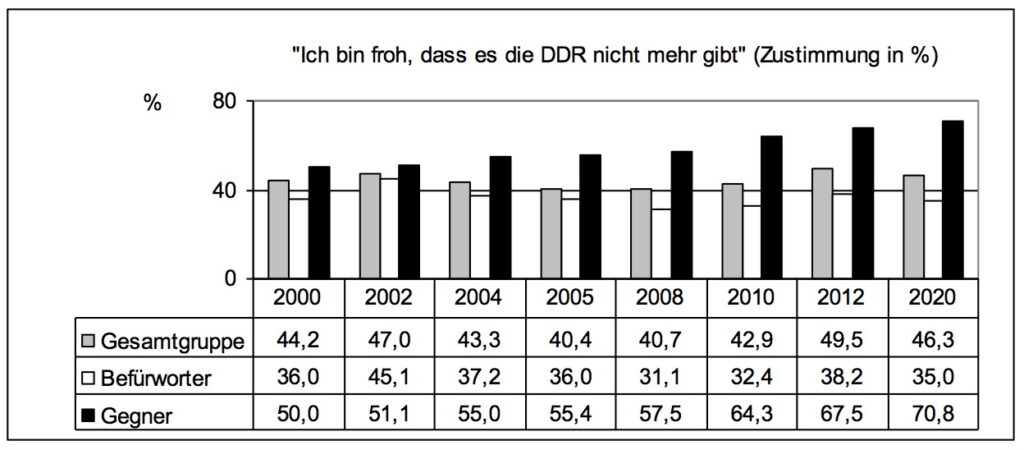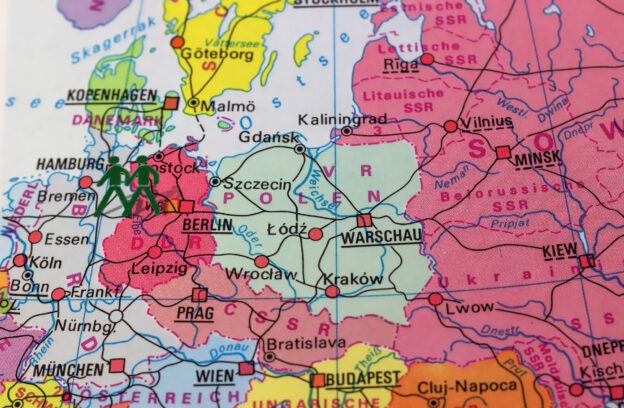The participants of the Saxon Longitudinal Study were all born in 1973 in the former GDR and grew up there until the reunification. Since there are data already available from the years 1987 to 1989 – i.e. before the German reunification – the Saxon Longitudinal Study examines the effect of socialization in the GDR to this day like no other study.
10 questions were selected from the three survey waves (before reunification) in 1987 to 1989 that were asked in each of the waves. Based on their content and wording, they measure the degree of system identification with socialism in the GDR. They included, i.e.:
- I have a safe future in the GDR” (Answer options: 1 completely, 2, 3, 4, 5 not at all)
- “I feel strongly connected to GDR as my socialist fatherland” (Answer options: 1 completely, 2, 3, 4, 5 not at all)
- “I am ready to defend GDR at all times with all my strength” (Answer options: 1 completely, 2, 3, 4, 5 not at all)
- “The future belongs to socialism, despite temporary setbacks” (Answer options: 1 completely, 2, 3, 4, 5 not at all)
All 10 questions were encoded in such way that a higher value expressed a higher approval rating. The answer options were then added up. Three values for system identification were then obtained (1987, 1988, 1989). The theoretical range of values on the scale ranged from 0 (perfect rejection) to 40 (perfect agreement). Values up to 20 express more likely to rejection, values greater than 20 support. Furthermore, for all 30 questions from 1987 to 1989, a total value of system identification before reunification was calculated (addition and division by 3) (detailed on the method see Berth et al., 2010).
The value for system identification was: 29.3 in 1987, 26.1 in 1988 and 22.9 in 1989. The identification with socialism in the GDR decreased significantly among the students from 1987 to 1989. Men tended to be somewhat more systemically critical than women. The total value of system identification 1987 to 1989 was divided into three groups (low, medium, high system identification). Like in many indicators of the longitudinal study, there is also shown a clear effect of the pre-1990 assessment after the reunification.

Figure: Agreeing with the statement “I am glad that the GDR no longer exists” in percentage, divided according to the system identification before the reunification, 2000 – 2020 (c) (r) Saxon Longitudinal Study, Prof. Dr. Hendrik Berth
The figure shows that agreeing with the statement “I am glad that the GDR no longer exists” is significantly lower (31 to 45% approval) among the supporters of the former system (high system identification) than among the former system opponents (low system identification, 50 to 70% approval).The more critical view of socialism in the GDR – measured before 1990 – continues to have an effect more than 30 years later. Agreeing with the statement has increased significantly among former opponents of the system, from 50% in 2000 to 70% in 2020. The assessment has hardly changed both in the sample as a whole and in the group of former system supporters.
Further evaluations examined whether going to a nursery in the GDR affects the state of health, attitudes, and opinions in the later course of life. Some researchers believed that going to the nursery in the GDR contributes significantly to the fact that authoritarian and far-right attitudes are much more widespread in East Germany. In the 2007 survey wave, 65.8% of the participants in the Saxon Longitudinal Study said they went to nursery. 31.1% were not in a nursery and 3.0% could not remember it. Intensive analyses of many different variables, such as mental state (Berth et al., 2010) or far-right attitudes (Berth et al., 2009), showed no evidence of a (harmful) influence of going to a nursery in the GDR.
References:
Berth, H., Förster, P., Brähler, E., Zenger, M. & Stöbel-Richter, Y. (2010). „Wir Thälmannpioniere lieben unser sozialistisches Vaterland, die Deutsche Demokratische Republik.“ – Was bleibt davon nach 20 Jahren? In E. Brähler & I. Mohr (Hrsg.), 20 Jahre deutsche Einheit – Facetten einer geteilten Wirklichkeit (S. 155-171). Gießen: psychosozial Verlag,
Berth, H., Förster, P., Balck, F., Brähler, E. & Stöbel-Richter, Y. (2010). Der Einfluss des frühkindlichen Krippenbesuchs auf die Psyche im jungen Erwachsenenalter. Psychotherapie, Psychosomatik, Medizinische Psychologie, 60, 73-77.
Berth, H., Förster, P., Balck, F., Brähler, E. & Stöbel-Richter, Y. (2009). Fördert der Besuch einer Kinderkrippe das Entstehen rechtsextremer Einstellungen? Verhaltenstherapie und psychosoziale Praxis, 41, 375–384.

